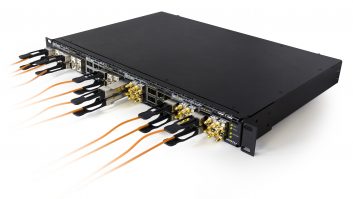Building an optimised infrastructure is critical to achieving the cost savings, added flexibility, and scalability that can come with the shift from SDI to IP. With its full product portfolio, Embrionix offers the market’s most adaptable redundant IP architecture — one that can be adapted to suit the particular requirements of any user and application.
Innovative solutions from Embrionix feature miniaturised and field-updatable signal-processing technology within its emSFP small-form-factor pluggable (SFP) modules that plug into commercial off-the-shelf (COTS) IP switch ports to simplify integration, reduce cabling and hardware requirements, and deliver the specific processing capabilities the user requires.
Together, Embrionix solutions allow broadcasters to improve on the dual spine/leaf topology typically implemented for an IP core deployment. This model employs top-of-rack (TOR) leaf switches, which are less-expensive switches equipped with lower-cost, lower-bandwidth ports (1GE, 10GE, 25GE) and some higher-bandwidth ports (40GE, 100GE). These leaf switches aggregate signals to the spine switch, a typically more expensive switch equipped mainly with costlier high-bandwidth ports.
Embrionix solutions include the emFUSION stand-alone gateway, emMODULAR aggregation frame, and new emVIRTU all-IP core infrastructure and media processing platform ̶ with functionalities such as up/down/cross-conversion and audio grooming to help users optimise the spine/leaf architecture. With these solutions, users can integrate processing within existing TOR switches, aggregate signals where possible for interconnection into the IP network more efficiently and establish direct connections to the spine (IP core switch) rather than through leaf switches.
Importantly, Embrionix devices support a granular mix-and-match approach that allows users to invest only in the I/O and processing they need, to simplify signal management for both local and remote devices, and to reduce cabling with cost-effective IP infrastructure that can scale readily with the next system expansion. Blending into the network, they enable the benefits of IP while leaving space and budget available for other core equipment.
8.B37







